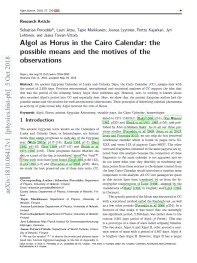Whilst
reading about the Sirius Binary
system [referred to in 3. Astronomy
Through the Ages] I found a news
report about another:
 Startling
evidence suggests the ancient
Egyptians understood the inner
mechanics of [the] binary star
system [Algol - also known as
the Demon Star], spinning
through our skies 93 light
years away... Startling
evidence suggests the ancient
Egyptians understood the inner
mechanics of [the] binary star
system [Algol - also known as
the Demon Star], spinning
through our skies 93 light
years away...The
binary system... was first
noted in modern astronomy by a
John Goodricke, back in 1783.
The Egyptians were huge
star-gazers, taking copious
and accurate notes about
changes in the heavens, and
using these to form
predictions about lucky and
unlucky parts of the day.
When Finnish researchers
studied the Cairo Calendar, a
badly-damaged but readable
calendar highlighting the good
and bad days of a year in
1200BC, they came to some
startling observations.
For the Egyptians not only
made observations, they made
conclusions and calculations
to figure out the inner
mechanisms of the stars for
their charts.
Two cycles were spotted in the
Cairo Calendar. One lasted
29.6 days - almost exactly
that of the lunar cycle.
And the other was 2.85 days -
which researchers from the
University of Helsinki in
Finland ascribe to the Algol
system.
And as the Egyptians made very
specific calculations, their
figures appear to have solved
a very modern puzzle.
The Algo system has now
been confirmed as a tertiary
system - three stars in total.
[Link] |
 I
then found this paper [source]
"Algol as Horus in the Cairo
Calendar: the possible means and the
motives of the observations" (to
read at a later date) I
then found this paper [source]
"Algol as Horus in the Cairo
Calendar: the possible means and the
motives of the observations" (to
read at a later date)
Algol is known
colloquially as the Demon Star...
The association of Algol with a
demon-like creature (Gorgon in the
Greek tradition, ghoul in the Arabic
tradition) suggests that its
variability was known long before
the 17th century, but there is still
no indisputable evidence for this...
The variability of
Algol was noted in 1667 by Italian
astronomer Geminiano Montanari, but
the periodic nature of its
variations in brightness was not
recognized until more than a century
later, when the British amateur
astronomer John Goodricke also
proposed a mechanism for the star's
variability...
This system ...
exhibits x-ray and radio wave
flares. The x-ray flares are thought
to be caused by the magnetic fields
of the A and B components... The
radio-wave flares might be created
by magnetic cycles similar to those
of sunspots, but because the
magnetic fields of these stars are
up to ten times stronger than the
field of the Sun, these radio flares
are more powerful and more
persistent...
Algol is about 92.8
light-years from the Sun, but about
7.3 million years ago it passed
within 9.8 light-years of the Solar
System[39] and its apparent
magnitude was about −2.5, which is
considerably brighter than the star
Sirius is today. Because the total
mass of the Algol system is about
5.8 solar masses, at the closest
approach this might have given
enough gravity to perturb the Oort
cloud of the Solar System somewhat
and hence increase the number of
comets entering the inner Solar
System....
The name Algol derives
from Arabic رأس الغول raʾs al-ghūl :
head (raʾs) of the ogre (al-ghūl)
(see "ghoul"). The English name
Demon Star was taken from the Arabic
name.
- - - - -
It seems to me that a number of
(more recent) astronomers have show
an interest in such star systems.
Take William Herschel for example
(mentioned on the
Astronomy Through The Ages
page).
 It
is said in Patrick Moore's book
'Astronomy for GCSE' p.14: It
is said in Patrick Moore's book
'Astronomy for GCSE' p.14:
"[William] Herschel did his best
to measure the distance of the
stars. He selected pairs of stars
(doubles) because he believed that
one member of the pair would be much
closer than the other, so that the
second star would be in the
background, so to speak; in this
case there should be a regular
apparent shift due to the Earth's
motion round the Sun. In fact, no
such shift was detected, because
most double stars are
physically-associated or binary
pairs, moving through space together
and at the same distance from us."
[To be continued...]
[Back
to Top]
|